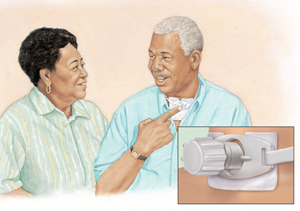Your Tracheostomy Tube: Learning How to Communicate
Your Tracheostomy Tube: Learning How to Communicate
Having a tracheostomy can affect your ability to talk and communicate with others. A speech therapist (a person trained to help people who have problems speaking) will work with you to address these problems. If you can't talk, you can learn other ways to express your thoughts and feelings to others.
If you can talk
Whether you can talk after a tracheostomy depends on why you have the tracheostomy tube (“trach tube”) as well as other factors, including the condition of your voice box. Many people with trach tubes still have vocal cords and can use these vocal cords to talk.
Certain trach tubes are designed to help with talking. Your healthcare provider will help you decide whether one of these tubes is right for you. Techniques and devices have been developed that help redirect airflow up through the voice box to produce speech.
If you can’t talk
If you can’t talk after your tracheostomy, you can still communicate. The tips below can help you do this. Your speech therapist and the rest of your healthcare team can also give you more suggestions:
Carry a pen and paper, a chalkboard, or a “wipe-off” board with you. Use them to write quick notes to others.
Use flash cards that say basic things, such as “thirsty” or “restroom.”
Try using a board with all the letters of the alphabet on it. Point to the letters to spell words.
Agree on the meanings of hand gestures with friends and family members.
Learn and use sign language.
Use facial expressions, such as a smile. They can help others understand how you’re feeling.
You may be a candidate for speech substitute or assistive devices. Technology continues to advance in this area. Your healthcare provider can review options that would be appropriate for you.
Updated:
March 21, 2017
Sources:
Hashiba, M. Development of a wearable electro-layrnx for laryngectomeis and its evaluation. Conference Proceedings: Annual International Conference of the IEE Engineering in medicine and Biology Society (2007); pp. 5267-5270, Kramp, B. Tracheostomy cannulas and voice prostheses. GMS Current Topics in Otorhinolarygology - Head and Neck Surgery (2009); 8; pp. doc05
Reviewed By:
Fetterman, Anne, RN, BSN,Mancini, Mary, MD
